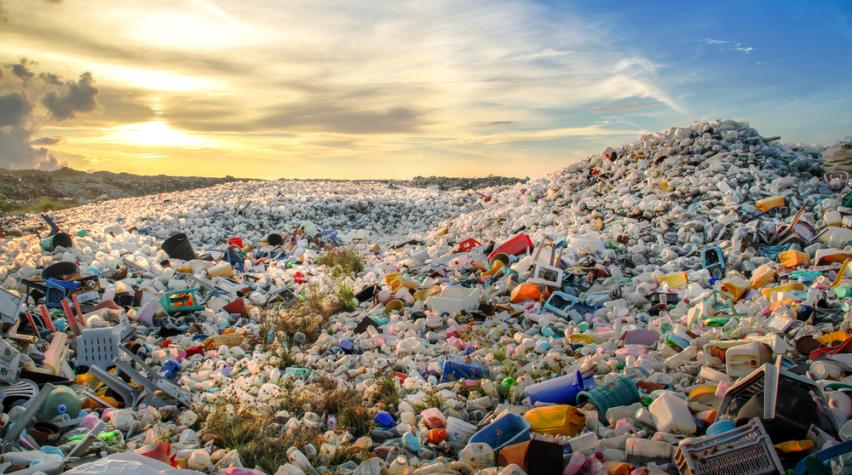
Dramatic images of plastic floating in our oceans and stories of its detriment to marine life have drawn the public’s attention to the plastics industry and especially plastic packaging, which accounts for 26% of all plastics used by volume. The United Nations (UN) estimates that the equivalent of a garbage truck’s worth of plastic waste is dumped into the ocean every minute, and a recent report by the Ellen MacArthur Foundation projects that by 2050, more plastic than fish will float in the ocean. Even in areas with formal recycling infrastructure, rates of recycling of plastic packaging are extremely low. Much of it ends up in landfills or is disposed of illegally, which negatively impacts natural systems that we depend on for resources.
The current state of plastic packaging
Current supply chains for plastic packaging are unsustainable. Not only does plastic waste cause harm to the environment and human health, but it also represents lost value for a major sector of the global economy. This material stream is being unnecessarily lost as waste after mostly single-use applications.
Despite its drawbacks, it is neither realistic nor wise to abandon or reduce the use of plastic packaging. Plastics are both functional and low cost. They improve resource efficiency by extending the shelf life of foods, thereby keeping more organic matter out of waste streams. And, as an alternative to wood and metal, they enable lightweight packages, which minimizes transportation fuel use.
A systematic approach
Opportunities exist to both increase profitability of plastic packaging and reduce its negative impacts, but this requires a shift from a linear to a circular economic model. This overhaul will require a systemic approach that moves beyond incremental progress. It will involve global collaboration among businesses, governments, and other organizations.
Ridding our natural systems of plastic waste will entail remediation as well as processes to keep new plastics from entering the environment. An effective post-use plastics economy is key to achieving the latter. Innovative recycling collection and sorting schemes that are drastically more effective and economical than existing methods need to be established. A vital counterpart to recycling efforts is finding high-value applications for the product streams and scaling up infrastructure capacity to match raw material supply.
Economic incentives to prevent plastic waste
Keeping plastic packaging out of the environment will require clear economic incentives for preventing these materials from turning into waste. A shift away from single-use to reusable packaging, for example, would increase resource productivity and capture maximum material value. Furthermore, since some leakage into the environment is unavoidable, packaging materials need to be less harmful.
Various stakeholders can be spurred to action on this issue by the benefits and incentives associated with making the shift. Governments will benefit from preserving their communities and public capital by minimizing the need for landfills and illegal waste disposal remediation, lowering healthcare costs, and realizing opportunities for public-private partnerships. Funding should be directed toward innovations that increase financial incentives for keeping materials out of the natural environment and in the circular value chain. Businesses supporting such initiatives will reap benefits of brand resonance, as well as realize opportunities for cost savings associated with emissions and alternative feedstocks.
End-of-life state of plastics
Many large-scale initiatives are emerging, backed by industry, that target the end-of-life stage of plastics to improve the economic, humanitarian, and environmental footprint of this sector. Some implement blockchain technology to enable better cooperation and faster adoption. In a blockchain, records of transactions cannot be tampered with once recorded. This provides traceability and transparency to ultimately ensure trust between the many stakeholders as the material changes hands throughout its value chain — from sourcing to production, to consumer, to end-of-life collection and reprocessing.
Plastic Bank
One such initiative is the Plastic Bank, which is building supply chains for ethically sourced plastic waste in which individual entrepreneurs are economically incentivized to collect plastic. The collected plastic can then be resold to brands for use in manufacturing or can be used by individuals as currency in local economies. Plastic Bank currently operates in Haiti and the Philippines (with plans to expand to Brazil, Indonesia, South Africa, the Vatican, Panama, and India) and is supported by industry, including Henkel and Shell, as well as IBM, which powers their blockchain platform. Another blockchain project that will target plastics supply chain management has been announced by Microsoft and Mojix and will help account for even hard-to-track plastics, such as straws, lids, and tear-open condiment containers.
We can expect to see real changes in the plastics packaging sector, driven by increased public awareness and outrage, and powered by modern innovation and technologies, as well as strong financial incentives.
This article originally appeared in the Technical Entity Trends column in the May 2018 issue of CEP. Members have access online to complete issues, including a vast, searchable archive of back-issues found at www.aiche.org/cep.


